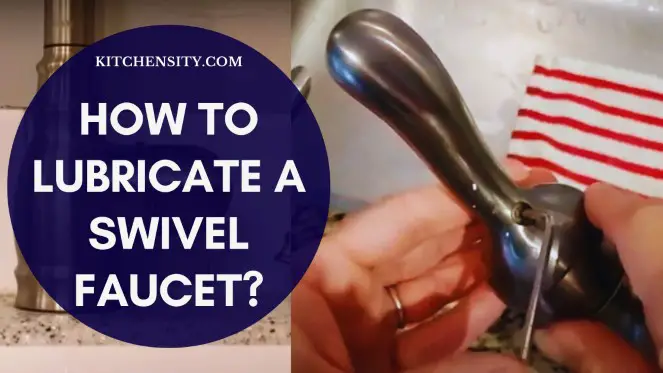A swivel faucet is a common fixture in most kitchens and bathrooms.
Over time, the swivel mechanism may become stiff and difficult to move, or the faucet may begin to make unpleasant noises.
This is often due to a lack of lubrication, which can cause the metal parts to grind against each other.
Lubricating your swivel faucet is an easy and inexpensive way to prevent this from happening and keep your faucet working smoothly for years to come.
In this article, we will guide you through the step-by-step process to lubricate a swivel faucet and help you to prevent this from happening.

Table of Contents
- 1 How To Lubricate A Swivel Faucet?
- 2 Why Lubricate Your Swivel Faucet?
- 3 Tools And Materials Needed
- 4 Step-By-Step Process To Lubricate A Swivel Faucet
- 5 What Is The Best Lubricant For Faucet Handles?
- 6 What Lubricant Do Plumbers Use?
- 7 Is Wd-40 Safe For Plumbing?
- 8 How To Lubricate Kitchen Faucet Handle?
- 9 Tips For Maintaining Your Swivel Faucet
- 10 Conclusion
- 11 YOU MAY ALSO LIKE
- 12 FAQs
- 12.1 How Often Should I Lubricate My Swivel Faucet?
- 12.2 Can I Use Any Type Of Lubricant On My Swivel Faucet?
- 12.3 Can I Lubricate My Swivel Faucet Without Disassembling It?
- 12.4 How Do I Know If My Swivel Faucet Needs Lubrication?
- 12.5 What If I Am Not Comfortable Performing This Maintenance Task Myself?
How To Lubricate A Swivel Faucet?
To lubricate a swivel faucet, turn off the water supply and remove the faucet handle. Clean the faucet stem and apply a small amount of silicone grease or plumber’s grease to the stem and inside of the handle. Reassemble the handle and turn the water supply back on to test for smooth operation.
This is the basic answer to your question. Please, refer below for a step-by-step process.
Why Lubricate Your Swivel Faucet?
Swivel faucets are an important fixture in the kitchen and the bathroom, providing a convenient way to control water flow and temperature.
Over time, the constant use of a swivel faucet can cause wear and tear on the faucet stem, which can result in difficulty turning the handle or leaks around the base of the faucet.
To prevent such issues, regularly lubricating your swivel faucet is an essential maintenance task that can help to keep your faucet working smoothly and prevent damage from occurring.
Here are some reasons why lubricating your swivel faucet is important:
- Swivel faucets are prone to wear and tear over time, which can cause difficulty turning the handle or leaks around the base of the faucet.
- Regular lubrication can help to reduce friction and wear, allowing the handle to turn more easily and reducing the risk of leaks.
- Lubricating your faucet is a simple and cost-effective way to extend the life of your faucet and prevent the need for costly repairs or replacements down the line.
- It is recommended to lubricate your faucet every six months to a year to keep it in top condition and ensure that it continues to provide reliable and efficient water flow for years to come.
Also Read – How To Fix A Stiff Kitchen Faucet?
Tools And Materials Needed
Before you start lubricating your swivel faucet, you will need the following tools and materials:
- Adjustable wrench
- Screwdriver
- Pliers
- Clean cloth
- Lubricant (silicone grease or plumber’s grease)
Step-By-Step Process To Lubricate A Swivel Faucet
Here are the step-by-step instructions for lubricating your swivel faucet:
Step 1: Turn Off The Water Supply
Here are the steps to follow to turn off the water supply before lubricating a swivel faucet:
- Locate The Shut-Off Valve: Look for the shut-off valve under the sink or near the water supply pipes. It may be a lever or knob that you need to turn.
- Turn Off The Water Supply: Once you have located the valve, turn it clockwise until it is fully closed. This will shut off the water supply to the faucet.
- Test The Water Supply: Turn on the faucet to check if the water supply has been completely shut off. If no water comes out, then you have successfully turned off the water supply.
By following these steps, you can ensure that no water will flow while you’re working on the faucet, which can prevent any accidents or water damage.
You May Also Like: How To Remove Kitchen Faucet Without Basin Wrench?
Step 2: Remove The Handle
The handle of a swivel faucet is typically attached to the faucet stem with a retaining screw, which holds the cartridge or valve in place.
To access this screw, you will need to remove the handle from the faucet. Here are the steps to follow:
- Locate The Screw: Depending on the type of faucet you have, the retaining screw may be located on the top of the handle or underneath a decorative cap. Use a flathead screwdriver or an Allen wrench to remove the screw.
- Remove The Handle: Once the screw has been removed, gently pull the handle off of the faucet stem. If the handle is stuck, try wiggling it back and forth while pulling it off to loosen it.
- Remove Any Remaining Components: Depending on the type of faucet you have, there may be additional components such as a decorative cover or a sleeve that need to be removed before you can access the cartridge or valve.
By following these steps and using the appropriate tools, you can safely remove the handle of your swivel faucet and gain access to the retaining screw and cartridge or valve.
This will allow you to proceed with the lubrication process and ensure that your faucet continues to function smoothly and efficiently.
You May Also Like: 6 Pull-Out Spray Kitchen Faucet Problems
Step 3: Disassemble The Faucet
Disassembling the faucet involves removing the retaining screw and any other components that are holding the cartridge or valve in place.
Here are the steps to follow:
- Use an adjustable wrench: Locate the retaining screw that is holding the cartridge or valve in place. Use an adjustable wrench to loosen and remove the screw. Be sure to keep track of the order in which the parts are removed.
- Remove the cartridge or valve: Once the retaining screw has been removed, you can carefully pull out the cartridge or valve from the faucet body. Be sure to note the orientation of the cartridge or valve, as this will be important when reassembling the faucet.
- Inspect the components: Take a moment to inspect the components of the faucet for any signs of wear or damage. If you notice any problems, such as cracks or leaks, you may need to replace the affected parts.
- Clean the components: Before applying any lubricant, it’s important to clean the components of the faucet thoroughly. Use a clean cloth or sponge to remove any dirt, debris, or mineral buildup from the faucet body and components.
By following these steps, you can safely disassemble your swivel faucet and prepare it for lubrication.
Be sure to keep track of the order in which the parts are removed and inspect them for any signs of wear or damage.
Cleaning the components thoroughly will also help ensure that the lubricant is applied evenly and effectively.
You May Also Like: How To Unclog A Sink Clogged With Coffee Grounds?
Step 4: Clean The Faucet Parts
This step is important because any dirt, debris, or old lubricant on the components can hinder the effectiveness of the new lubricant.
Here’s how to clean the parts:
- Gather Your Materials: To clean the faucet parts, you’ll need a clean cloth or sponge, warm water, and possibly a mild detergent or vinegar solution.
- Remove Any Visible Debris: Use a clean cloth or sponge to remove any visible dirt, debris, or mineral buildup from the faucet body and components. Pay special attention to the swivel mechanism, as this area can be prone to buildup and residue.
- Clean The Components: If the components are especially dirty or covered in mineral buildup, you may need to use a mild detergent or vinegar solution to clean them. Simply mix a small amount of detergent or vinegar with warm water and use a clean cloth or sponge to scrub the parts.
- Dry The Components: Once the components have been cleaned, be sure to dry them thoroughly with a clean cloth or towel. Any leftover moisture can interfere with the lubrication process.
By cleaning the faucet parts before lubrication, you’ll help ensure that the new lubricant can work effectively.
Be sure to pay special attention to the swivel mechanism, as this area can be prone to buildup and residue.
By following these steps, you can help extend the life of your swivel faucet and ensure that it operates smoothly and efficiently.
Also Read – How To Remove Flow Restrictor From The Kitchen Faucet?
Step 5: Apply The Lubricant
This step is important because it helps ensure that the faucet handle and swivel mechanism move smoothly and without any resistance.
Here’s how to apply the lubricant:
- Choose Your Lubricant: The best lubricants for a swivel faucet are silicone grease or plumber’s grease. Avoid using other types of lubricants, as they can attract dirt and debris and cause more harm than good.
- Apply The Lubricant: Using a small amount of lubricant, apply it to the swivel mechanism and any other metal parts that rub against each other. Be sure to cover all of the necessary parts, but do not over-lubricate. Over-lubrication can cause the lubricant to attract dirt and debris, which can hinder the effectiveness of the lubricant.
- Reassemble The Faucet: Once you have applied the lubricant, reassemble the faucet in the reverse order in which you disassembled it. Be sure to tighten all screws and fittings securely, but not too tightly.
By applying the correct lubricant to the swivel mechanism, you can help extend the life of your swivel faucet and ensure that it operates smoothly and efficiently.
Remember to use only a small amount of lubricant and to reassemble the faucet correctly once you have finished.
Step 6: Reassemble The Faucet
After cleaning and lubricating the faucet parts, it’s time to put everything back together.
This is where you need to be extra careful to ensure that everything is reassembled properly.
- Start by placing the cartridge or valve back into the faucet body, and then tighten the retaining screw with a screwdriver.
- Next, reattach the handle to the faucet and tighten the screw that holds it in place.
- Finally, turn on the water supply and test the faucet to make sure that everything is working properly.
- Check for any leaks or drips, and make sure that the faucet handle moves smoothly and without any resistance.
If everything seems to be working properly, you can consider the job done.
However, if you notice any issues, you may need to disassemble the faucet again and check for any problems.
Sometimes, a small adjustment or additional lubrication may be necessary to get everything working smoothly.
Also Read – How To Fix A Leaky Kitchen Faucet?
Step 7: Turn On The Water Supply
This is an important step because it ensures that the faucet is working properly and that your efforts in lubricating it were successful.
- To turn on the water supply, simply open the shut-off valve underneath the sink.
- Once the water is flowing, check for any leaks around the base of the faucet or around the handles.
- If you notice any leaks, tighten the fittings or connections as necessary.
- If there are no leaks, turn off the water supply again and replace the handle.
- Make sure that the handle is tightened securely so that it doesn’t wiggle or move around.
Overall, lubricating your swivel faucet is an easy and important maintenance task that can help keep your faucet functioning properly and extend its lifespan.
By following these simple steps, you can ensure that your swivel faucet is well-lubricated and free of any issues.
What Is The Best Lubricant For Faucet Handles?
The best lubricant for faucet handles is silicone grease or plumber’s grease specifically designed for plumbing applications.
- These types of lubricants are typically non-toxic and safe to use on all types of faucets, including those made of plastic, brass, or stainless steel.
- They are also highly resistant to water and other liquids, which can help prevent corrosion and extend the lifespan of your faucet handles.
- When applying the lubricant, be sure to follow the manufacturer’s instructions carefully, and use a small amount to avoid excess buildup that can attract dirt and debris.
With proper lubrication, your faucet handles should operate smoothly and quietly for years to come.
Also Read – How To Remove Handle From Faucet?
What Lubricant Do Plumbers Use?
Plumbers typically use silicone grease or plumber’s grease when lubricating plumbing fixtures and fittings.
- These lubricants are specifically designed for use in plumbing applications and are highly resistant to water, heat, and chemicals.
- Silicone grease and plumber’s grease are typically non-toxic, making them safe to use on all types of plumbing systems, including those that carry drinking water.
- They can also help prevent corrosion and extend the lifespan of plumbing components.
When applying lubricant, plumbers will typically use a small amount and distribute it evenly to ensure proper coverage and reduce the risk of excess buildup that can attract dirt and debris.
Is Wd-40 Safe For Plumbing?
While WD-40 can be effective for many household tasks, it is generally not recommended for use in plumbing applications.
- WD-40 is primarily designed as a degreaser and solvent, and it is not specifically formulated for use with plumbing fixtures or fittings.
- Additionally, WD-40 can potentially break down rubber seals and gaskets over time, leading to leaks and other plumbing issues.
If you need to lubricate a plumbing component, it is best to use silicone grease or plumber’s grease specifically designed for plumbing applications.
These lubricants are safe, effective, and designed to work with all types of plumbing systems.
How To Lubricate Kitchen Faucet Handle?
Lubricating a kitchen faucet handle is a simple process that can help keep your faucet working smoothly and prevent wear and tear. Here are the steps to lubricate a kitchen faucet handle:
- Turn Off The Water Supply: Before you begin, turn off the water supply to your kitchen faucet by closing the shut-off valves located under the sink.
- Remove The Handle: Most kitchen faucet handles are held in place by small set screws located on the underside of the handle. Use a screwdriver to remove the set screw, and then gently pull the handle off the faucet stem.
- Clean The Faucet Stem: Using a clean cloth or rag, wipe down the faucet stem to remove any dirt, debris, or old lubricant.
- Apply Lubricant: Apply a small amount of silicone grease or plumber’s grease to the faucet stem and the inside of the handle. Be sure to use a lubricant that is specifically designed for plumbing applications.
- Reassemble The Handle: Once the lubricant has been applied, reattach the handle to the faucet stem and tighten the set screw.
- Turn On The Water Supply: Finally, turn the water supply back on and test the faucet handle to ensure that it moves smoothly and without any squeaking or grinding noises.
By following these simple steps, you can lubricate your kitchen faucet handle and keep it working smoothly for years to come.
Also Read – How To Fix A Spinning Faucet Handle?
Tips For Maintaining Your Swivel Faucet
- Clean your swivel faucet regularly to prevent dirt and debris buildup.
- Avoid using abrasive cleaners or scrubbers on your faucet, as this can damage the finish and cause scratches.
- Check for leaks and other plumbing issues regularly, and address them promptly to avoid further damage.
- If your swivel faucet is still difficult to move or makes unpleasant noises after lubrication, it may be time to replace the cartridge or valve.
Conclusion
Lubricating a swivel faucet may seem like a small task, but it can make a big difference in the smooth operation and longevity of your faucet.
By following these simple steps and using the right lubricant, you can keep your faucet working properly for years to come.
Remember to always turn off the water supply and take your time when disassembling and reassembling the faucet.
By taking care of your faucet, you can avoid costly repairs or replacements down the line. So don’t hesitate to lubricate your swivel faucet today and enjoy the benefits of a smoothly functioning fixture in your kitchen or bathroom.
YOU MAY ALSO LIKE
- How To Clean Plastic Kitchen Sink?
- Tighten A Loose Moen Single Handle Kitchen Faucet & Base [3 Steps]
- How To Remove Flow Restrictor From The Kitchen Faucet?
FAQs
-
How Often Should I Lubricate My Swivel Faucet?
It is recommended to lubricate your swivel faucet at least once a year.
-
Can I Use Any Type Of Lubricant On My Swivel Faucet?
It is best to use silicone grease or plumber’s grease specifically designed for plumbing applications.
-
Can I Lubricate My Swivel Faucet Without Disassembling It?
While it is possible to lubricate some parts of the faucet without disassembling it, a full disassembly is recommended for best results.
-
How Do I Know If My Swivel Faucet Needs Lubrication?
If your swivel faucet is making unpleasant noises or feels stiff and difficult to move, it may need lubrication.
-
What If I Am Not Comfortable Performing This Maintenance Task Myself?
You can always hire a professional plumber to lubricate your swivel faucet or address any other plumbing issues you may be experiencing.
Katrina Smith is a seasoned expert with over 25 years of experience in all things related to cooking and the kitchen. As an avid cook and kitchen enthusiast, she is passionate about sharing her knowledge and expertise on cookware, kitchen appliances, kitchen tips, and kitchen staples.
Through her articles and reviews, Katrina aims to inspire and help others improve their cooking skills, experiment with different ingredients, and invest in quality cookware and appliances.

![How To Unclog A Sink Clogged With Coffee Grounds? [3 Effective Ways] 3 How-to-Unclog-a-Sink-Clogged-With-Coffee-Grounds](https://www.kitchensity.com/wp-content/uploads/2020/06/How-to-Unclog-a-Sink-Clogged-With-Coffee-Grounds.jpg)


![Best Insulation Under The Kitchen Sink [3 Top Insulations] 6 Best Insulation Under The Kitchen Sink](https://www.kitchensity.com/wp-content/uploads/2023/04/Best-Insulation-Under-The-Kitchen-Sink.jpg)

